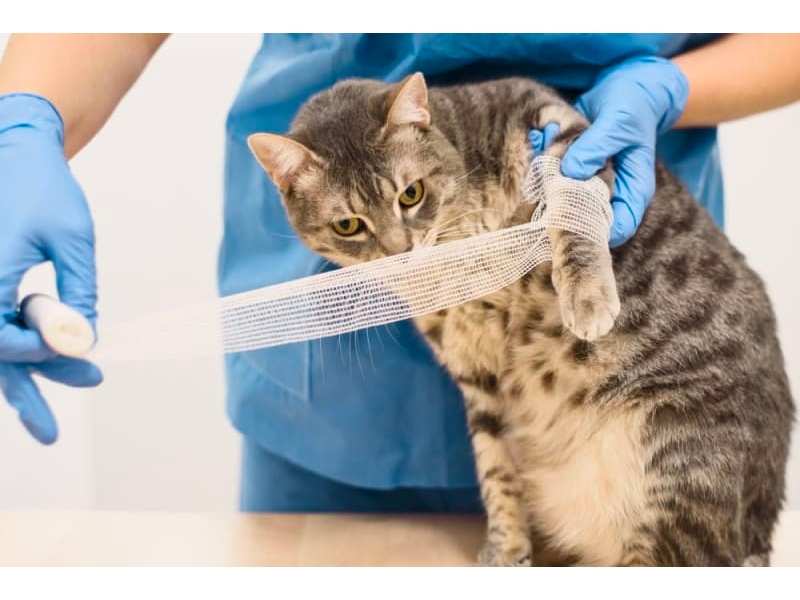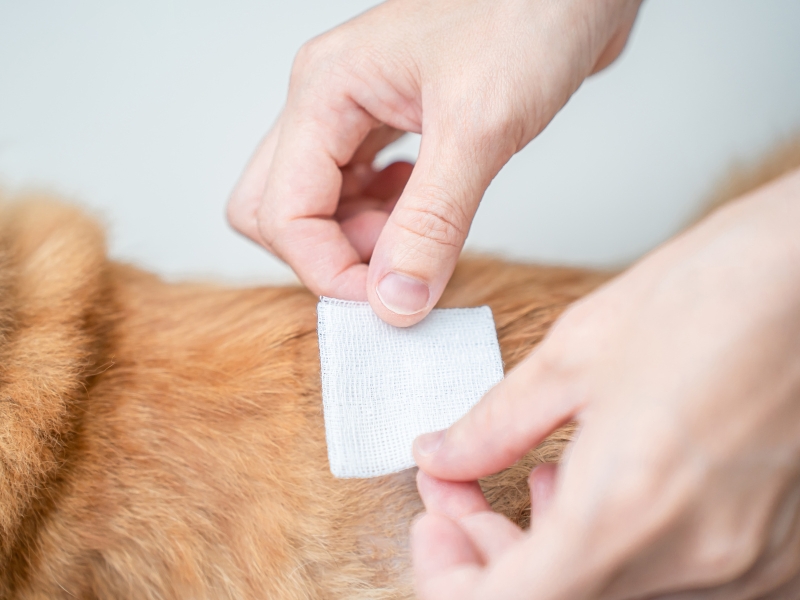Anyone who owns a feline should know how to provide cat wound care. Pets may get wounds from various causes, including fights, accidents, and infections. These injuries need prompt medical treatment to ensure a full recovery and avoid further issues. This Canvas Personalized article provides expert advice on how to treat your cat’s wounds at home and when to take them to the vet. Your kitten will heal more quickly and less discomfort if you follow these guidelines.
Understanding Cat Wounds
While some wounds are apparent, some are minor or in regions you may not see often. That is why it is critical to understand what behaviors to look out for and the apparent physical symptoms that your cat has a wound. Cat wound treatment can vary depending on the type, location, and severity of the injury, so knowing how to identify and care for different damages is essential.

If you have an outdoor cat, checking for injuries every time they return from their day’s adventure is a good idea. You never know what exciting adventures your cat got up to while they were outside. Taking note of unusual habits is another method to keep up with your cat.
Signs of Feline Wounds
Cats are masters at disguising their pain. That is because their feral side is hardwired to hide any signs of weakness. An obviously hurt cat is easy prey for other animals. These symptoms indicate that your pet needs feline wound care may include:
- Tenderness
- Torn Skin
- Missing Fur
- Limping
- Pain
- Bleeding

These symptoms below may develop if a wound is not noticed in time and is allowed to worsen or become infected:
- Fever
- Abscess
- Pus/Discharge
Common Wounds in Cats
If your cat exhibits any of the symptoms as mentioned above, they may be suffering from one of the following:
- Scratches
- Hotspots
- Cuts
- Ulcers
- Scrapes
- Burns
- Skin Rashes
- Insect Bites
When to take a cat to the vet for a wound?
If your cat exhibits any concerning signs, including infection, significant bleeding, broken limbs, fever, or other severe injuries, you should immediately take it to the vet. Kitten wound care can be more challenging than adult cats as kitties have weaker immune systems. They are more prone to dehydration and shock.

Be sure to call the vet if you are unsure whether your cat’s injury requires medical attention. They will be able to evaluate your condition and advise you on whether or not you need to see a doctor. Always use extreme care when thinking about your cat’s health.
Cat wound healing stages

Effective tips:
It is essential to have a cat wound care kit at your home.
Step 1: Look for signs of infection
You first need to figure out if the cat’s wound is fresh or old. It is possible for an old hurt to get infected, in which case medications and veterinary care would be necessary. If you are looking for home remedies for cat wounds, you should only use them on minor injuries that are not infected.
Step 2: Determine the extent of the injury
After determining that an infection is not present and that the damage is really recent, the severity of the wound must be assessed. A simple eye test can usually tell you how serious the problem is. If your cat has been injured and needs stitches, surgery, or a cast, you should get them to the doctor as soon as possible.

Step 3: Manage the bleeding
If your cat is bleeding from a small wound, the bleeding must be stopped. Use a clean towel or sterile gauze to apply direct pressure to the damage. A clot will form in 5-10 minutes, depending on the location and depth of the laceration. If the wound is not clotting correctly, take your cat to the clinic immediately.
Step 4: Disinfect cat’s wound
How to clean a cat wound? You can gently clean minor wounds and abrasions with a moist cloth and an iodine or saline solution. You may need to remove extra hair from the wound region initially and even trim the hair if required. Clear any debris from the wound site as gently as possible without rubbing.
Step 5: Apply the cat wound care products
After disinfecting, the next step is to hasten the healing process and protect against further bacterial infections. In this case, you should stock up on sterile, non-stick gauze and antiseptic solutions for cats.

Advanced Methods of Cat Wound Care
How to care for an infected wound on a cat?
Your cat’s health is at risk if you don’t take good care of an open or deep wound. To treat infected wounds in cats, the doctor may use different methods, such as antibiotics, surgical cleaning (removing dirty tissue), and special bandages.
Cat wound healing is a complex process that involves inflammation, tissue formation, and remodeling. When you take your pet to the doctor, they will give you specific advice on how to treat an open wound. They may also suggest some cat-specific wound care products to help your kitten heal faster. In addition, your vet may also prescribe pain relievers if your cat is also suffering discomfort as a consequence of their wound.

Care of open wounds on cats
Animal bites and scratches, as well as sticks, thorns, glass, or metal items that pierce the skin, are common causes of puncture wounds. Even little punctures may cause significant damage to the unseen tissues under the skin.
You can disinfect the wound by following the steps mentioned. Keep in mind that unless instructed to do so by your vet, you should not clean an open wound with anything, including soaps, shampoos, rubbing alcohol, hydrogen peroxide, herbal remedies, tea tree oil, and so on.
Effective tips:
If your cat has an open wound, a protective collar may be necessary.

Cat wound not healing after surgery
Most abscesses should be cured within five to seven days if treated properly. Cellulitis-related edema may take longer to resolve. If you suspect the wound is not healing correctly, ask your veterinarian. Feline wound care is essential to prevent complications and ensure optimal recovery for your cat.
The veterinarian may suggest further testing to determine the source of the infection if the wound does not heal after a few days of therapy. Your cat’s recovery from illness may be hampered by viruses that weaken the immune system, such as the feline immunodeficiency virus (FIV) and the feline leukemia virus (FeLV). These viral infections may be detected with blood testing.
A prolonged draining wound may indicate the presence of foreign material (e.g. a broken tooth, claw, or soil) in the injury, which may need surgical examination. It suggests the existence of an uncommon infectious agent, in which case biopsies for culture and sensitivity, as well as other tests, may be required.

Home Care and Monitoring for Feline Wound Care
After you have done all in your power to save your cat, all you can do is sit back and watch nature take its course. Avoid giving your cat any opportunities to lick, gnaw, or scratch the wound. Ensure the damage is not growing infected by checking it daily and changing the bandage as needed.
For the first several days, you should continue to clean and examine the wound 1-2 times each day. After that, reapply the antibacterial spray to the wound’s perimeter and reinstall the bandage.

Note:
Please be aware that the content of this page is for informational purposes only and is not to be construed as professional veterinary medical advice. Please schedule an appointment with your veterinarian for a proper diagnosis of your pet’s condition.

>>> More from Canvas Personalized:
- 10 Best Cat Ear Cleaners Recommended by Vets – Top Picks
- 12 Most High-Quality Cat Food in 2023 – Recommended by Vets
To sum up, cat wound care is critical to the health of your feline pet. By following these tips, you can provide your furbaby with the most excellent care possible and hasten its recovery. Stay tuned to Canvas Personalized for insights and guidance on caring for your pet.










